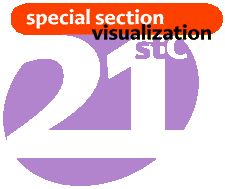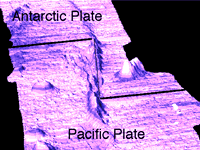

SEEING EVERYTHING:
Visualization in history
 At Lamont-Doherty Earth Observatory in Palisades,
N.Y., senior scientist Bill Ryan invites you to go on a virtual reality
voyage to the bottom of the sea. When you arrive, your invisible underwater vehicle whips
you across the seafloor while you watch it split apart before your eyes. "This trip takes only a
few minutes," Ryan says, "but in the real world the process actually takes millions of years."
At Lamont-Doherty Earth Observatory in Palisades,
N.Y., senior scientist Bill Ryan invites you to go on a virtual reality
voyage to the bottom of the sea. When you arrive, your invisible underwater vehicle whips
you across the seafloor while you watch it split apart before your eyes. "This trip takes only a
few minutes," Ryan says, "but in the real world the process actually takes millions of years."Over at Columbia's new Positron Emission Tomography (PET) Center, a volunteer lies on a bed with his head in a tunnel. He has just watched a video math puzzle and is trying to solve it. From his cogitation come color slides of his brain's interior, showing blood movement through the cortex. Columbia psychologist Lynn Cooper, on observing the results, says, "I never would have believed when I started in psychology that some day I would see inside the brain while it was thinking."
Not since the invention of printing has a communication tool attracted so much excitement as computer visualization. The visual affects virtually every human activity. Biology has its double helix, planetary astronomy its faded blue Apollo 10 Earth view, and protein chemistry its squid-like molecules.
Medicine uses visualization wherever doctors probe, diagnose, or operate. Oncologists can see hidden tumors inside the brain, and surgeons can visualize the anatomical point to separate the joined heads of Siamese twins. Pharmaceutical researchers create molecular models of the AIDS virus and explore its response to potential therapies.
Perhaps visualization's most far-reaching impact is in advertising, news production, and entertainment. Most video commercials now operate with computer-generated imaging, either simulating real-world events that are out of our range or creating views that once could exist only in imagination. The most recent expression of this trend is virtual reality, placing the observer in an environment of sights and sounds that mimic the real world and change with the participants' actions.
Experts not often given to hype have called visualization an explosion of techniques unparalleled since Galileo invented the telescope or Janssen the microscope. Nicholas Turro, chairman of the chemistry department at Columbia, who works on visualizing chemical processes, calls visualization the leading educational technology of the future. Nicholas Negroponte, director of the Media Lab at M.I.T., says visualization is one of the most important tools for tapping cyberspace. And Robert Beck, head of the University of Chicago's Center of Imaging Science, takes a global view: "In visualization we are on the brink of a cultural revolution of unprecedented proportions."
This revolution is deeply rooted in how we know and communicate our knowledge. In the past we understood the world largely through the eye, which evolution has finely tuned to read a narrow band of energy from the sun. But what the eye extracts, we later discovered, is only a small part of reality. There are worlds in other bands of energy that require novel instrumentation for us to "see." And now we "see" so much we depend on machines to analyze the multitude of images and data that constantly confront us.
But what about words? Historically, visual and verbal thinking have engaged in a constant tug of war for domination of the human cognitive turf. Cave wall paintings in Spain and France testify to the importance of the eye as a tool for hunters in prehistoric times. But as humans turned to other activities, verbal thinking took over. The word allowed humans to analyze and record their experience, to separate themselves from the rest of nature, and to create law and order, science, and systems of education--civilization's trappings. For thousands of years the written word orchestrated and disciplined the affairs of human society.
But tension between word and image continued. In the years before the first millennium, the image was believed to have divine status; it became, as Pope Gregory I noted, the source of knowing. Images were the literature of the laity, he wrote, adding presciently that the image was the source of education for the great majority of Europeans, who were illiterate. This viewpoint declined historically when the Iconoclasts attacked the divinity of images, especially Christian images, and aroused mobs to destroy churches and their contents. From then on, the authority of the word was never really challenged --until recently.
In the past century, the visual has returned to its place as a preeminent education and communications tool. The first practical camera, invented in 1835, brought a new sense of the eye's mastery by making permanent whatever was seen. Photography with its probative values furthered the age of science and industry, providing them with a strong, stable record of the past and present.
Other technologies soon allowed poking inside hitherto hidden areas, beginning in 1895 when Roentgen discovered X-rays and developed the first non-optical technique to image bones and organs inside the body. Today's photographic instruments create images in infrared, ultraviolet, microwave, and gamma rays, each energy band revealing different properties of an object. Magnetism, sound, and particle beams also can generate visual representations.
The digital computer makes all information on an object available simultaneously. In the 1950s and '60s image processing was used almost exclusively to enhance and correct images transmitted by NASA spacecraft. The Ranger, Mariner, and Surveyor missions brought the moon and planets into every home. In the '80s the Landsat 4 satellite provided multispectral color images of Earth through invisible electromagnetic radiation, which showed spectacular scenes of mountain ranges, mineral deposits, flowing rivers, and growing crops. In the early '90s the Hubble Space Telescope sent back images of distant sections of the universe not seen in such detail or beauty before. The image became a source of new information and new power.
 Computerized medical imaging first appeared in
the '70s and was met with skepticism by the medical profession over its accuracy. But as
technology overcame these objections, diagnostic imaging with computers gradually became as
acceptable as the X-ray film. Today, with computer-assisted tomography (CAT or CT), PET,
magnetic resonance imaging (MRI), ultrasound, and other methods, medicine depends on
visualization resources.
Computerized medical imaging first appeared in
the '70s and was met with skepticism by the medical profession over its accuracy. But as
technology overcame these objections, diagnostic imaging with computers gradually became as
acceptable as the X-ray film. Today, with computer-assisted tomography (CAT or CT), PET,
magnetic resonance imaging (MRI), ultrasound, and other methods, medicine depends on
visualization resources.
In addition to clinical use, some of these devices are now important in psychological and physiological research. Dr. Ronald van Heertum, director of Columbia's new PET center, says PET is opening a new dimension in imaging by graphically representing blood flow inside the brain, showing how it works and which regions are involved during cognitive and emotional activity.
The latest development in imaging involves marrying PET and MRI in certain experimental applications. At the University of Chicago, for instance, MRI brain scans have been superimposed for the first time on PET scans. The combined image, produced in three dimensions, enables doctors to see structural and functional aspects of the brain together and in proper alignment. (1)
The inundation of our society with images and image-making machinery of course attracts critical attention. University of Chicago art historian Barbara Stafford writes that "Plato's critique of the unreal, seductive, and dangerous image has resurfaced with a vengeance."(2) The strong anti-image bias of much contemporary art criticism is only a symptom of a deeper concern. Many fret that the multiplicity of media images, especially as they become interactive, have considerable potential for manipulating public opinion. Special-interest messages in which viewers press buttons and get one-sided movies are cases in point.
While images can have strong political power--viz. the unforgettable photo of a young Chinese student standing defiantly in front of a tank at Tiananmen Square--the possibilities of imagery fraud loom large with the advance of image-processing technology. Such strategies as smoothing, noise removal, segmentation, correlation mapping, and time-variation imagery blur the distinction between fiction and non-fiction. "Forrest Gump's" computer-created interview with President Kennedy and a recent Scientific American cover of Marilyn Monroe arm in arm with Abe Lincoln (3) are amusing examples of digital play, but they also signal a powerful alarm. Evidently "seeing is believing" can no longer be accepted at face value in movies, in business, in the courtroom, or at the crime scene. Even science has to be careful of the deceitful image based on distorted statistics. "Educators need to encourage visual analysis and criticism," says Professor Conrad Johnson of Columbia Law School. "Just as one can play tricks with Xerox copies, one can play tricks with computer-generated images. Just as you learn not to believe everything you read in a newspaper, don't believe everything you see on your computer screen."
FOOTNOTES
-
Beck, Robert N., address to American
Association for the Advancement of Science conference on imaging science, Atlanta,
1995.
Scientific American, February 1994.




